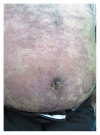Characteristics of Primary Cutaneous T-Cell Lymphoma in Iran: A 10-Year Retrospective Study
- PMID: 27437467
- PMCID: PMC4897041
- DOI: 10.1155/2014/820921
Characteristics of Primary Cutaneous T-Cell Lymphoma in Iran: A 10-Year Retrospective Study
Abstract
Background. Primary cutaneous T-cell lymphomas (CTCLs) are a group of extranodal non-Hodgkin lymphomas that may be present in the skin without any evidence of extracutaneous disease. The aim of this study was to evaluate the epidemiological characteristics of primary CTCL in Isfahan, Iran. Method. A total of 95 patients who were diagnosed as having primary CTCL were recruited during a 10-year period (2003-2013) and were classified according to the new WHO-EORTC criteria. Results. The patient group consisted of 43 (44.8%) males and 53 (55.2%) females, which indicated a female predominance (M : F ratio 1 : 1.2). The mean age at the time of diagnosis was 41.78 ± 16.88 years (range: 7-84 years). Prior to diagnosis, the lesions had persisted for a mean of 8.34 ± 4.38 years (range: 0-55 years). The age at peak diagnosis was 20-40 years (43%). The most frequent subtypes were mycosis fungoides (MF) (88.5%). Four patients died from CTCL-related complications. Conclusions. The distinguishing epidemiologic characteristics of primary CTCL, particularly those MF, in Iran, are the absence of a male predominance and lower age at diagnosis. This is likely because of the characteristic ethnic group diversity and increased susceptibility among younger population.
Figures
Similar articles
-
Primary cutaneous lymphomas: A clinical and histological study of 99 cases in Isfahan, Iran.J Res Med Sci. 2015 Sep;20(9):827-31. doi: 10.4103/1735-1995.170595. J Res Med Sci. 2015. PMID: 26759567 Free PMC article.
-
Second Primary Malignancies in CTCL Patients from 1992 to 2011: A SEER-Based, Population-Based Study Evaluating Time from CTCL Diagnosis, Age, Sex, Stage, and CD30+ Subtype.Am J Clin Dermatol. 2016 Feb;17(1):71-7. doi: 10.1007/s40257-015-0155-3. Am J Clin Dermatol. 2016. PMID: 26386881
-
Non-mycosis fungoides cutaneous lymphomas in a referral center in Taiwan: A retrospective case series and literature review.PLoS One. 2020 Jan 24;15(1):e0228046. doi: 10.1371/journal.pone.0228046. eCollection 2020. PLoS One. 2020. PMID: 31978091 Free PMC article. Review.
-
Clonal disease in extracutaneous compartments in cutaneous T-cell lymphomas. A comparative study between cutaneous T-cell lymphomas and pseudo lymphomas.Arch Dermatol Res. 1996 Apr;288(4):163-7. doi: 10.1007/BF02505218. Arch Dermatol Res. 1996. PMID: 8967786
-
Primary cutaneous T-cell lymphoma (mycosis fungoides and Sézary syndrome): part I. Diagnosis: clinical and histopathologic features and new molecular and biologic markers.J Am Acad Dermatol. 2014 Feb;70(2):205.e1-16; quiz 221-2. doi: 10.1016/j.jaad.2013.07.049. J Am Acad Dermatol. 2014. PMID: 24438969 Review.
Cited by
-
The Landscape of Cutaneous T-Cell Lymphoma (CTCL) in the Middle East and North Africa (MENA) and the Establishment of the MENA CTCL Working Group.Cancers (Basel). 2024 Oct 2;16(19):3380. doi: 10.3390/cancers16193380. Cancers (Basel). 2024. PMID: 39410000 Free PMC article. Review.
-
Mycosis fungoides in Iranian population: an epidemiological and clinicopathological study.J Skin Cancer. 2015;2015:306543. doi: 10.1155/2015/306543. Epub 2015 Jan 28. J Skin Cancer. 2015. PMID: 25694829 Free PMC article.
-
Primary cutaneous lymphomas: A clinical and histological study of 99 cases in Isfahan, Iran.J Res Med Sci. 2015 Sep;20(9):827-31. doi: 10.4103/1735-1995.170595. J Res Med Sci. 2015. PMID: 26759567 Free PMC article.
-
Insights Into the Molecular and Cellular Underpinnings of Cutaneous T Cell Lymphoma.Yale J Biol Med. 2020 Mar 27;93(1):111-121. eCollection 2020 Mar. Yale J Biol Med. 2020. PMID: 32226341 Free PMC article. Review.
-
Correlation between mycosis fungoides and pregnancy.Saudi Med J. 2016 Sep;37(9):968-72. doi: 10.15537/smj.2016.9.15838. Saudi Med J. 2016. PMID: 27570852 Free PMC article.
References
-
- Wilcox R. A. Cutaneous T-cell lymphoma: 2014 update on diagnosis, risk-stratification, and management. American Journal of Hematology. 2014;89:837–851. - PubMed
LinkOut - more resources
Full Text Sources
Other Literature Sources



